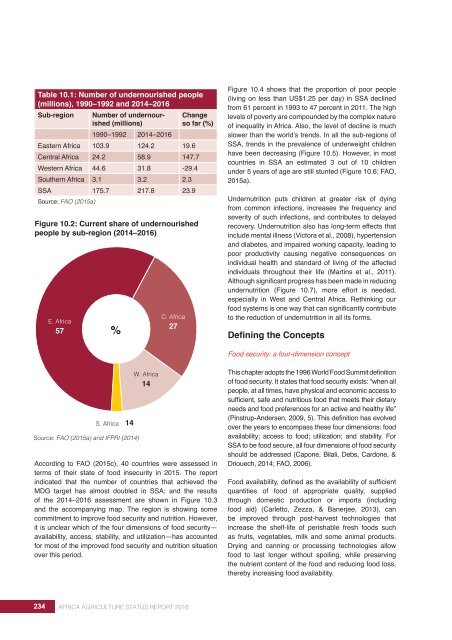AFRICA AGRICULTURE STATUS REPORT 2016
AASR-report_2016-1
AASR-report_2016-1
You also want an ePaper? Increase the reach of your titles
YUMPU automatically turns print PDFs into web optimized ePapers that Google loves.
Table 10.1: Number of undernourished people<br />
(millions), 1990–1992 and 2014–<strong>2016</strong><br />
Sub-region<br />
Number of undernourished<br />
(millions)<br />
1990–1992 2014–<strong>2016</strong><br />
Change<br />
so far (%)<br />
Eastern Africa 103.9 124.2 19.6<br />
Central Africa 24.2 58.9 147.7<br />
Western Africa 44.6 31.8 -29.4<br />
Southern Africa 3.1 3.2 2.3<br />
SSA 175.7 217.8 23.9<br />
Source: FAO (2015a)<br />
Figure 10.2: Current share of undernourished<br />
people by sub-region (2014–<strong>2016</strong>)<br />
E. Africa<br />
57<br />
%<br />
C. Africa<br />
27<br />
Figure 10.4 shows that the proportion of poor people<br />
(living on less than US$1.25 per day) in SSA declined<br />
from 61 percent in 1993 to 47 percent in 2011. The high<br />
levels of poverty are compounded by the complex nature<br />
of inequality in Africa. Also, the level of decline is much<br />
slower than the world’s trends. In all the sub-regions of<br />
SSA, trends in the prevalence of underweight children<br />
have been decreasing (Figure 10.5). However, in most<br />
countries in SSA an estimated 3 out of 10 children<br />
under 5 years of age are still stunted (Figure 10.6; FAO,<br />
2015a).<br />
Undernutrition puts children at greater risk of dying<br />
from common infections, increases the frequency and<br />
severity of such infections, and contributes to delayed<br />
recovery. Undernutrition also has long-term effects that<br />
include mental illness (Victora et al., 2008), hypertension<br />
and diabetes, and impaired working capacity, leading to<br />
poor productivity causing negative consequences on<br />
individual health and standard of living of the affected<br />
individuals throughout their life (Martins et al., 2011).<br />
Although significant progress has been made in reducing<br />
undernutrition (Figure 10.7), more effort is needed,<br />
especially in West and Central Africa. Rethinking our<br />
food systems is one way that can significantly contribute<br />
to the reduction of undernutrition in all its forms.<br />
Defining the Concepts<br />
Food security: a four-dimension concept<br />
S. Africa<br />
14<br />
Source: FAO (2015a) and IFPRI (2014)<br />
W. Africa<br />
14<br />
According to FAO (2015c), 40 countries were assessed in<br />
terms of their state of food insecurity in 2015. The report<br />
indicated that the number of countries that achieved the<br />
MDG target has almost doubled in SSA; and the results<br />
of the 2014–<strong>2016</strong> assessment are shown in Figure 10.3<br />
and the accompanying map. The region is showing some<br />
commitment to improve food security and nutrition. However,<br />
it is unclear which of the four dimensions of food security—<br />
availability, access, stability, and utilization—has accounted<br />
for most of the improved food security and nutrition situation<br />
over this period.<br />
This chapter adopts the 1996 World Food Summit definition<br />
of food security. It states that food security exists: “when all<br />
people, at all times, have physical and economic access to<br />
sufficient, safe and nutritious food that meets their dietary<br />
needs and food preferences for an active and healthy life”<br />
(Pinstrup-Andersen, 2009, 5). This definition has evolved<br />
over the years to encompass these four dimensions: food<br />
availability; access to food; utilization; and stability. For<br />
SSA to be food secure, all four dimensions of food security<br />
should be addressed (Capone, Bilali, Debs, Cardone, &<br />
Driouech, 2014; FAO, 2006).<br />
Food availability, defined as the availability of sufficient<br />
quantities of food of appropriate quality, supplied<br />
through domestic production or imports (including<br />
food aid) (Carletto, Zezza, & Banerjee, 2013), can<br />
be improved through post-harvest technologies that<br />
increase the shelf-life of perishable fresh foods such<br />
as fruits, vegetables, milk and some animal products.<br />
Drying and canning or processing technologies allow<br />
food to last longer without spoiling, while preserving<br />
the nutrient content of the food and reducing food loss,<br />
thereby increasing food availability.<br />
234 <strong>AFRICA</strong> <strong>AGRICULTURE</strong> <strong>STATUS</strong> <strong>REPORT</strong> <strong>2016</strong>


